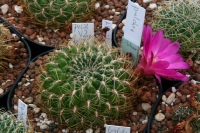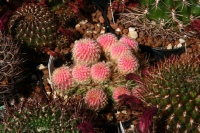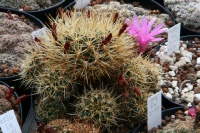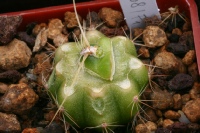
Copyright © Claude Bourleau. All rights reserved.

"The pulchra case "
What about S. pulchra ? Early this year, in his article in Succulenta, Johan described
a new species : Sulcorebutia callichroma. S. callichroma is nothing else than the
well-
Johan believes he has rediscovered the original collection site of S. puchra. Therefore
he thinks to have a real Sulcorebutia pulchra in the person of its VZ 642. This one
fits exactly to the original description. It was therefore logical to rename the
HS 78. Similarly, HS 78a that was called S. pulchra v. longispina becomes Sulcorebutia
callichroma v. longispina.
The variety albiareolata (which I did not know, I have to recognize it ...) which
was described by Slaba & Sorma in 2007, is elevated to the range of species. Some
field numbers of this Sulcorebutia albiareolata: VZ 309 -




S. pulchra VZ 642/1
S. pulchra VZ 642/2
S. pulchra VZ 642/3
S. pulchra VZ 642/5



Some S. albiareolata
S. albiareolata VZ 349/6
S. albiareolata VZ 350
Just for the pleasure, let’s continue the visit of the collection ! Either my eyes
are drawn to a plant out of the ordinary, or Johan attracts my attention by saying
: "-
Anyway, we could spend the whole day and still find some interesting things !




S. glomeriseta MC 4399
S. menesesii MC 5532
Weingartia cintiensis
S. sp. KK 1769 « glomerispina »




S. spec. Quiroga VZ 390/3
S. breviflora v. haseltonii
VZ 589/1
S. santiaginiensis VZ 340/4
(damaged apex, rose offsets)
S. juckeri VZ 429




S. callichroma v. longispina
VS 347 (ident. to HS 78a)
S. caracarensis MC 6309
S. juckeri HJ 1150
W. spec. HJ 1195




S. crispata RMR 0415
Some splendid weingartias
Some S. tiraquensis
v. totorensis
S. krahnii

S. spec. EH 6278




S. cantargalloensis VZ 617/1
S. tunariensis VZ 613/2
S. juckeri VZ 430/5
Some S. patriciae
also white spined clones




Up there, there is yet to see!
General view
At the end of the visit, we went through the greenhouse in which Johan propagates the plants. I can guarantee that there will be a big choice in the future lists of plants!
I have also had the pleasure of seeing a propagation technique that I did not know
: areole grafting. In fact, this technique is not new : it was born and has been
used for quite some time now in Eastern European countries.





Some grafted areoles. The areole is held in place on the rootstock with an adhesive
tape, a small piece of plastic bubble is placed on the graft. Elastic can be used
in addition to further improve the contact graft-
Different stages of development of the grafts.



Habitat seedlings of some clones of S. robert-
Habitat seedlings of S. vargsii VZ 692
A wonderful grafted S. purpurea v. unguispina WR 731
I do not want to end this page without telling you that I was really amazed again
by the collection of Johan de Vries. I repeat it again : any Sulcorebutia lover MUST
visit this collection (I wonder if Johan will agree -
Well, it's time for me to hit the road as Ilona and Cor Noorman are waiting for me!
Elizabeth & Johan de Vries -